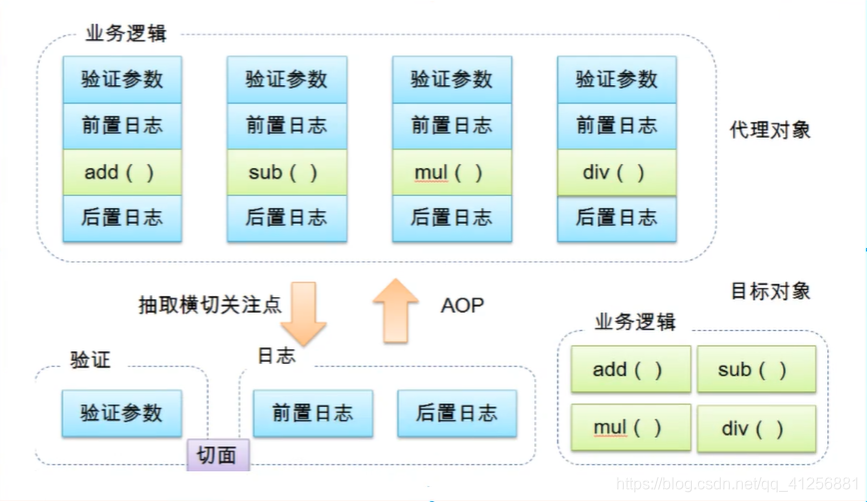1、什么是AOP?
AOP(Aspect Oriented Programming)意为:面向切面编程,通过预编译方式和运行期动态代理实现程序功能的统一维护的一种技术。AOP是OOP的延续,是软件开发中的一个热点,也是Spring框架中的一个重要内容,是函数式编程的一种衍生泛型,利用AOP可以对业务逻辑的各个部分进行隔离,从而使得业务逻辑各部分之间的耦合度降低,提高程序的可重用性,同时提高了开发的频率。

AOP中的名词解释:
- 横切关注点:跨越应用程序多个模块的方法或功能。即是,与我们业务逻辑无关的,但是我们需要关注的部分,就是横切关注点,如日志、安全、缓存、事务等等……
- 切面(ASPECT):横切关注点被模块化的特殊对象,即是一个类。
- 通知(Advice):切面必须要完成的工作,即是类中的一个方法。
- 目标(Target):被通知对象。
- 代理(Proxy):向目标对象应用通知之后创建的对象。
- 切入点(PointCut):切面通知执行的“地点”的定义。
- 连接点(jointPoint):与切入点匹配的执行点。

AOP在不改变原有代码的情况下,去增加新的功能。
使用Spring实现AOP
导入的依赖包
<!-- https://mvnrepository.com/artifact/org.aspectj/aspectjweaver -->
<dependency>
<groupId>org.aspectj</groupId>
<artifactId>aspectjweaver</artifactId>
<version>1.8.10</version>
</dependency>
方式一
使用Spring的API接口【主要SpringAPI接口实现】
1.UserService
public interface UserService{
void add();
void delete();
void update();
void select();
}
2.UserServiceImpl
public class UserServiceImpl implements UserService {
public void add() {
System.out.println("增加了一个用户");
}
public void delete() {
System.out.println("删除了一个用户");
}
public void update() {
System.out.println("修改了一个用户");
}
public void select() {
System.out.println("查询了一个用户");
}
}
3.BeforeLog
public class BeforeLog implements MethodBeforeAdvice {
//method:要执 行的目标对象的方法
//args:多数
//target:目标对象
@Override
public void before(Method method, Object[] args, Object target) throws Throwable {
System.out.println(target.getClass().getName() + "的" + method.getName() + "被执行了");
}
}
4.AfterLog
public class AfterLog implements AfterReturningAdvice {
//returnValue;返问值
@Override
public void afterReturning(Object returnValue, Method method, Object[] args, Object target) throws Throwable {
System.out.println("执行了" + method.getName() + "方法。返回结果为" + returnValue);
}
}
5.applicationContext.xml
<?xml version="1.0" encoding="UTF-8"?>
<beans xmlns="http://www.springframework.org/schema/beans"
xmlns:xsi="http://www.w3.org/2001/XMLSchema-instance"
xmlns:aop="http://www.springframework.org/schema/aop"
xsi:schemaLocation="http://www.springframework.org/schema/beans
https://www.springframework.org/schema/beans/spring-beans.xsd
http://www.springframework.org/schema/aop
https://www.springframework.org/schema/aop/spring-aop.xsd">
<!--注册bean-->
<bean id="userService" class="com.tt.service.UserServiceImpl"/>
<bean id="beforeLog" class="com.tt.log.BeforeLog"/>
<bean id="afterLog" class="com.tt.log.AfterLog"/>
<!--方式一 :使用原生Spring API接口1-->
<!--配置aop:需要导入aop的约束-->
<aop:config>
<!--切入点: expression: 表达式,execution( 要执行的位置! * ****)-->
<!--execution(修饰符,哪个类,哪个方法(方法后参数不限))-->
<aop:pointcut id="pointcut" expression="execution(* com.tt.service.UserServiceImpl.*(..))"/>
<!--执行环绕增加! -->
<aop:advisor advice-ref="beforeLog" pointcut-ref="pointcut"/>
<aop:advisor advice-ref="afterLog" pointcut-ref="pointcut"/>
</aop:config>
</beans>
6.MyTest
public class MyTest {
public static void main(String[] args) {
ApplicationContext context = new ClassPathXmlApplicationContext("applicationContext.xml");
//动态代理代理的是接口:注意点
UserService userService = (UserService) context.getBean("userService");
userService.add();
}
}
方式二
自定义来实现AOP【主要是切面定义】
1.DiyPointCut
public class DiyPointCut {
public void before() {
System.out.println("=======方法执行前=======");
}
public void after() {
System.out.println("=======方法执行后=======");
}
}
2.applicationContext.xml
<?xml version="1.0" encoding="UTF-8"?>
<beans xmlns="http://www.springframework.org/schema/beans"
xmlns:xsi="http://www.w3.org/2001/XMLSchema-instance"
xmlns:aop="http://www.springframework.org/schema/aop"
xsi:schemaLocation="http://www.springframework.org/schema/beans
https://www.springframework.org/schema/beans/spring-beans.xsd
http://www.springframework.org/schema/aop
https://www.springframework.org/schema/aop/spring-aop.xsd">
<!--注册bean-->
<bean id="userService" class="com.tt.service.UserServiceImpl"/>
<!--方式二:自定义类-->
<bean id="diy" class="com.tt.diy.DiyPointCut"/>
<aop:config>
<!--自定义切面,ref 要引用的类-->
<aop:aspect ref="diy">
<!--切入点-->
<aop:pointcut id="point" expression=" execution(* com.tt.service.UserServiceImpl.*(..))"/>
<!--.通知-->
<aop:before method="before" pointcut-ref="point"/>
<aop:after method="after" pointcut-ref="point"/>
</aop:aspect>
</aop:config>
</beans>
3.MyTest
public class MyTest {
public static void main(String[] args) {
ApplicationContext context = new ClassPathXmlApplicationContext("applicationContext.xml");
//动态代理代理的是接口:注意点
UserService userService = (UserService) context.getBean("userService");
userService.add();
}
}
方式三
1.AnnotationPointCut
//方式三:使用注解方式实现AOP
@Aspect //标注这个类是一个切面
public class AnnotationPointCut {
@Before("execution(* com.lenovo.service.UserServiceImpl.*(..))")
public void before() {
System.out.println("====方法执行前=====");
}
@After("execution(* com.lenovo.service.UserServiceImpl.*(..))")
public void after() {
System.out.println("====方法执行后=====");
}
//在环绕增强中,我们可以给定一一个参数。代表我们要获取处理切入的点:
@Around("execution(* com.tt.service.UserServiceImpl.*(..))")
public void around(ProceedingJoinPoint jp) throws Throwable {
System.out.println("环绕前");
//Signature signature = jp.getSignature();//获得签名
//System.out.println("signature:" + signature);
Object proceed = jp.proceed(); //执行方法
System.out.println("环绕后");
//System.out.println(proceed);
}
}
2.applicationContext.xml
<?xml version="1.0" encoding="UTF-8"?>
<beans xmlns="http://www.springframework.org/schema/beans"
xmlns:xsi="http://www.w3.org/2001/XMLSchema-instance"
xmlns:aop="http://www.springframework.org/schema/aop"
xsi:schemaLocation="http://www.springframework.org/schema/beans
https://www.springframework.org/schema/beans/spring-beans.xsd
http://www.springframework.org/schema/aop
https://www.springframework.org/schema/aop/spring-aop.xsd">
<!--注册bean-->
<bean id="userService" class="com.tt.service.UserServiceImpl"/>
<!--方式三-->
<bean id=" annotationPointCut" class="com.tt.diy.AnnotationPointCut"/>
<!--开启注解支持! -->
<aop:aspectj-autoproxy/>
</beans>
3.MyTest
public class MyTest {
public static void main(String[] args) {
ApplicationContext context = new ClassPathXmlApplicationContext("applicationContext.xml");
//动态代理代理的是接口:注意点
UserService userService = (UserService) context.getBean("userService");
userService.add();
}
}
